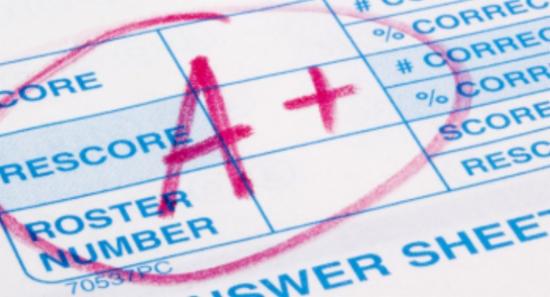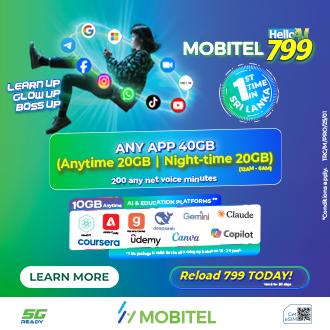.webp)

Two Sri Lankan school rivals become co-creators of YouTube's AI-powered dubbing tool
(YouTube Blog); 80% of the world doesn’t speak English. What that means for YouTube is a lot of great content isn’t fully accessible to the rest of the world. That’s why we’re introducing an AI-powered dubbing tool to lessen the language barrier on our platform — so that everything from educational explainers to the latest viral trend can reach a global audience. The tool, called Aloud, was developed as part of Google’s in-house incubator, Area 120, and led by two longtime friends, Buddhika Kottahachchi and Sasakthi Abeysinghe. Behind every great product is a great story, so we sat down with them both to learn more about Aloud and their journey from high school rivals to close collaborators and friends.
Not only are you both originally from Sri Lanka, but you actually knew each other growing up! Tell us that story.
Sasakthi: We were both into competitive programming as kids and represented rival high schools! Buddhika and I met as we were training together to represent Sri Lanka for the SEARCC and IOI competitions. We were slight anomalies in that space — we were both more of hackers of code, than implementers of textbook algorithms — so we bonded and kept in touch over the years. Funny enough, our careers brought us both to Google (and now YouTube) so we started hanging out again and collaborating on different ideas.
Where did the idea for Aloud come from? What led you to start creating it together?
Sasakthi: We were bored during COVID lockdowns and started brainstorming interesting problems to solve. Buddhika came up with the idea of dubbing video content after not being able to watch the 3rd season of Borgen since the voice actors required to dub it couldn’t meet in the studio, and I was excited about the opportunity to work on some really hard and impactful problems. We both saw the potential value, but wanted to make sure that we did it the right way, so we were very intentional about how we developed the team to make sure that we established a culture of respect, friendship, collaboration, and curiosity.
Buddhika: Dubbing had a transformative impact on me as a child. TV was introduced in Sri Lanka when I was still a toddler and I didn’t speak English. All the content initially available was in English, so TV was little more to me than a magical box with people inside. But, gradually more and more content from around the world was dubbed into the language I spoke, Sinhala. Shows like “Towards 2000” and “That’s Incredible!” became accessible and sparked my interest in technology.
There’s a shift with knowledge moving from written form to video. As mobile phone use increases that knowledge is theoretically accessible to more and more people through platforms like YouTube, but language remains a barrier. We’re super excited about the prospect for Aloud to bridge that gap.
Aloud.ai was first created as part of Area 120 at Google. What was it like building an entirely new product? How did it compare to the rest of the roles you’d had at the company?
Sasakthi: In many ways it was like a startup. There was a lot of autonomy, a lot of room for creative problem-solving and a lot of challenges that we had to overcome but being at Google also had amazing perks. We had access to the amazing talent, technology and distribution capabilities that Google had to offer. It was an awesome learning experience and something that gave us the opportunity to think holistically.
Buddhika, your official job title is Head of Product, YouTube Dubbing. What do you oversee? What does your day to day look like?
Buddhika: My focus is on figuring out the best experience for our users, both the creators who make videos and the viewers who watch them. To do this, I’m constantly seeking out different perspectives. For example, I recently participated in a hackathon with some creators visiting YouTube and one of them asked me why the translations sometimes sounded slightly robotic. So, with that insight, I started brainstorming with some of my awesome colleagues in Google Research to explore ways we could make the translated speech more expressive. By constantly keeping an eye out for these gaps and connecting them with potential solutions, we’re able to keep making the product even better!
Sasakthi, you’re the Team Lead and the Principal Software Engineer for Aloud. What is your biggest goal when you go to work every day?
Sasakthi: My primary goal is to empower and enable the team to do amazing things. I encourage the team to challenge assumptions and help them remove roadblocks, but our team is amazing and they are the ones that make the magic happen.
What’s the reception for Aloud been like so far? What’s next?
Buddhika: We’re seeing an extremely positive response from both creators and viewers with an overwhelming volume of requests for early access from all across the world. It’s exciting to see dubbed content reaching new, enthusiastic Spanish and Portuguese-speaking audiences. People are finally able to embrace their local language and culture without having to give up on the plethora of knowledge, content and opportunities that are available in other languages.
We truly believe that in the next 5-10 years the language barrier will be a thing of the past, bringing the world even closer together, so we’re motivated to bring this to more creators as quickly as possible and expand to additional languages.
What are your creative outlets outside of work?
Sasakthi: Around 2007, I learned how to play the guitar using YouTube videos. Since then, I have been using YouTube to learn dozens of different things from photography and astrophotography to wood working to welding to even figuring out how to fix my microwave and AC when it stopped working. My most recent endeavor is to build a remote controlled lawn mower that can mow on very steep terrains. (If you are asking why not just buy it, where is the fun in that?! ) Other than that, I love anything to do with the outdoors, and enjoy skiing, hiking and rock climbing.
Buddhika: For a long time my primary creative outlet was building stuff with code, but in the past few years, cooking has taken on that role. Luckily, YouTube provides an endless stream of inspiration for that. I’m also a big fan of smart home technologies and am constantly looking for ways to reduce and automate the chores I have to do.
You’ve known each other for nearly three decades, what are the pros and cons of being both co-founders and friends?
Buddhika: For pros, the trust and psychological safety that comes from being close friends makes working together so much easier. There is never a hard topic that we can’t discuss and the two of us can cover for each other when needed.
Sasakthi: We used to hear from a lot of our peer-founders that being a founder can be a lonely endeavor. For us that was (and is) never the case. The only con that comes to mind is that I have to listen to Buddhika’s jokes every day.
Buddhika: I want to point out that they do sometimes make you laugh!
Sasakthi: You do. We really make a great team and I couldn’t imagine doing this with anyone else.
Read the original YouYube Blog Here.
Other Articles
Featured News





.png )
-793492-797477_850x460-797844_550x300.jpg)









-797273_550x300.jpg)



















.gif)